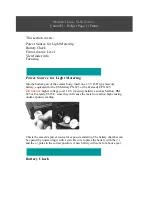
www.amico.com
11
Cylinder Changing Procedures
1. Keep the main bank valve open throughout these procedures.
2. Close cylinder valves on all empty cylinders.
3. Disconnect pigtails from cylinder valve outlets using an appropriate wrench.
4. Place protective caps over the cylinder valves of the empty cylinders and move them aside.
5. Remove protective caps of the full cylinders. Visually inspect the cylinder valves for dust, grease and oil.
6. Using a clean (lint free) cloth, wipe each cylinder valve outlet clean. Do not use your fingers.
7. Standing to one side, “crack” the cylinder valves by briefly opening and closing them to blow out any dust. Make
sure they are pointing away from you and other personnel.
8. Connect the pigtails to the cylinder valve outlets and tighten the nut with an appropriate wrench.
9. Very S-L-O-W-L-Y open the cylinder valve on the cylinder closest to the control cabinet. Watch the bank pressure
display on the front of the cabinet to make sure the pressure rises slowly to the full cylinder pressure reading.
10. Wait one full minute.
11. Proceed to S-L-O-W-L-Y open the remaining cylinder valves one at a time.
WARNING:
High pressure Oxygen systems must be handled with CAUTION. Spontaneous combustion
may result if Oxygen comes in contact with grease or oil. Ensure that hands, gloves, clothing and tools
are kept clean and free of oil and grease. Be careful not to introduce dust or other contaminants into the
system when changing cylinders. Failure to comply with this procedure may be hazardous.
WARNING:
Fire hazard. DO NOT permit smoking or any other source of ignition in the area where the
manifold is located or near the relief valve vent outlet. Be certain that all connections are free of dirt, grease
and oil. These substances burn with great intensity in air enriched with Oxygen or Nitrous Oxide and some
gas mixtures.


































